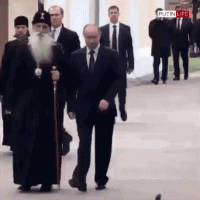Even if the Russians overwhelm the Ukrainian conventional army, they will ultimately lose an insurgent war when/if they try to occupy Ukraine.
Putin and his military advisors thought the Ukraine army would sh*t their pants, and simply surrender.
They were wrong. Dead wrong. Ukraine will NEVER surrender.
Putin is now stuck in a Chinese finger trap of his own making.
Gonna be an endless stream of body bags coming back to Mother Russia.
If the past is anything to go by, Russia will struggle to occupy Ukraine
CNN Updated: March 2, 2022 12:53 PM
Ukraine’s resistance to the Russian invasion has shown strength that has surprised many observers, but one expert has warned historical precedent bodes poorly for Moscow’s forces in the long term should it be unable to subdue the country quickly.
“The Russian army is overextended and in a precarious position if Ukraine becomes a protracted war,” Seth Jones, vice president of the Center for Strategic and International Studies, a Washington, DC-based think tank, said in a social media post.
“Assuming 150,000 Russian soldiers in Ukraine and a population of 44 million, that is a force ratio of 3.4 soldiers per 1,000 people. You can’t hold territory with those numbers,” Jones said.
He compared that Russian force ratio to occupations after previous wars around the world, saying successful ones had force ratios that were “astronomically higher.”
For example, he said, the Allied forces occupying Germany in 1945 had 89.3 troops to 1,000 inhabitants; NATO forces in Bosnia in 1995, 17.5 troops to 1,000 inhabitants; NATO forces in Kosovo in 2000, 19.3 to 1,000, and international forces in East Timor in 2000, 9.8 to 1,000.
Writing in the 2003 review of the RAND Corp. think tank, analyst and mathematician James Quinlivan said a benchmark force ratio for a successful occupation is about 20 to 1,000....
And if Russian occupiers face a guerrilla war in the event the Ukrainian government falls, odds won’t be in their favor, he said.
“They will be in serious danger of being picked apart by Ukrainian insurgents.”
And again, looking at past conflicts, Russia faces formidable challenges in taking Ukraine’s urban areas, like the capital, Kyiv.
“Urban terrain offers incredible resources and advantages for a defending force to cause disproportionate numbers of causalities on an attacking element, cause the attacker to run out of time in the strategic environment, and ultimately bring the momentum of an attack to a screeching halt,” John Spencer and Jayson Geroux wrote this month for the Modern War Institute at West Point, home of the US Military Academy.
The pair, former US and Canadian military officers respectively, pointed to conflicts from World War II to the Korean War to Chechnya to Syria, where urban defenders were able to inflict high losses on their attackers.
With a 40-mile (64-kilometer) column of Russian military vehicles and armor lined up in the direction of Kyiv, what Spencer and Geroux point out happened to Russian armor in Grozny, in Chechnya, in 1995, might be especially ominous for Moscow’s current forces.
Chechen separatists, operating in teams with as few as two men, and using only rifles, grenades and grenade launchers, set on Russian armored vehicles from basements and the upper floors of buildings, they wrote.
“Main tanks and other weapons could not effectively return fire,” Spencer and Geroux said.
“Once in their trap, ambush teams would strike the vulnerable points of Russian tanks and armored personnel carriers, hit the lead and trail vehicles, quickly withdraw, and then move up the flanks to strike the now paralyzed Russian columns again,” they said.
Over three days in January 1995, one Russian brigade lost 102 of its 120 armored vehicles and 20 of 26 tanks to the Chechen separatists in Grozny, they said.
If this example even holds partially true for what the Russian invaders will face in Ukraine’s cities, the war will not be coming to any quick end.



